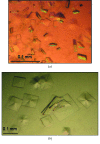Crystallization and preliminary X-ray diffraction analysis of mouse galectin-4 N-terminal carbohydrate recognition domain in complex with lactose
- PMID: 18607104
- PMCID: PMC2443957
- DOI: 10.1107/S1744309108017405
Crystallization and preliminary X-ray diffraction analysis of mouse galectin-4 N-terminal carbohydrate recognition domain in complex with lactose
Abstract
Galectin-4 is thought to play a role in the process of tumour conversion of cells of the alimentary tract and the breast tissue; however, its exact function remains unknown. With the aim of elucidating the structural basis of mouse galectin-4 (mGal-4) binding specificity, we have undertaken X-ray analysis of the N-terminal domain, CRD1, of mGal-4 in complex with lactose (the basic building block of known galectin-4 carbohydrate ligands). Crystals of CRD1 in complex with lactose were obtained using vapour-diffusion techniques. The crystals belong to tetragonal space group P42(1)2 with unit-cell parameters a = 91.1, b = 91.16, c = 57.10 A and preliminary X-ray diffraction data were collected to 3.2 A resolution. An optimized crystallization procedure and cryocooling protocol allowed us to extend resolution to 2.1 A. Structure refinement is currently under way; the initial electron-density maps clearly show non-protein electron density in the vicinity of the carbohydrate binding site, indicating the presence of one lactose molecule. The structure will help to improve understanding of the binding specificity and function of the potential colon cancer marker galectin-4.
Figures

Similar articles
-
Cloning, expression, purification, crystallization and preliminary X-ray diffraction analysis of the N-terminal carbohydrate-recognition domain of human galectin-4.Acta Crystallogr Sect F Struct Biol Cryst Commun. 2010 May 1;66(Pt 5):542-5. doi: 10.1107/S1744309110010778. Epub 2010 Apr 29. Acta Crystallogr Sect F Struct Biol Cryst Commun. 2010. PMID: 20445255 Free PMC article.
-
Structure of the mouse galectin-4 N-terminal carbohydrate-recognition domain reveals the mechanism of oligosaccharide recognition.Acta Crystallogr D Biol Crystallogr. 2011 Mar;67(Pt 3):204-11. doi: 10.1107/S0907444911004082. Epub 2011 Feb 15. Acta Crystallogr D Biol Crystallogr. 2011. PMID: 21358051
-
Structural characterisation of human galectin-4 N-terminal carbohydrate recognition domain in complex with glycerol, lactose, 3'-sulfo-lactose, and 2'-fucosyllactose.Sci Rep. 2016 Feb 1;6:20289. doi: 10.1038/srep20289. Sci Rep. 2016. PMID: 26828567 Free PMC article.
-
Structural characterization of human galectin-4 C-terminal domain: elucidating the molecular basis for recognition of glycosphingolipids, sulfated saccharides and blood group antigens.FEBS J. 2015 Sep;282(17):3348-67. doi: 10.1111/febs.13348. Epub 2015 Jul 14. FEBS J. 2015. PMID: 26077389
-
Galectin-4 in normal tissues and cancer.Glycoconj J. 2004;20(4):247-55. doi: 10.1023/B:GLYC.0000025819.54723.a0. Glycoconj J. 2004. PMID: 15115909 Review.
Cited by
-
Cloning, expression, purification, crystallization and preliminary X-ray diffraction analysis of the N-terminal carbohydrate-recognition domain of human galectin-4.Acta Crystallogr Sect F Struct Biol Cryst Commun. 2010 May 1;66(Pt 5):542-5. doi: 10.1107/S1744309110010778. Epub 2010 Apr 29. Acta Crystallogr Sect F Struct Biol Cryst Commun. 2010. PMID: 20445255 Free PMC article.
References
-
- Ackerman, S. J., Liu, L., Kwatia, M. A., Savage, M. P., Leonidas, D. D., Swaminathan, G. J. & Acharya, K. R. (2002). J. Biol. Chem.277, 14859–14868. - PubMed
-
- Barondes, S. H., Castronovo, V., Cooper, D. N., Cummings, R. D., Drickamer, K., Feizi, T., Gitt, M. A., Hirabayashi, J., Hughes, C., Kasai, K. et al. (1994). Cell, 76, 597–598. - PubMed
-
- Brewer, F. C. (2002). Biochim. Biophys. Acta, 1572, 255–262. - PubMed
-
- Cao, Z., Said, N., Amin, S., Wu, H. K., Bruce, A., Garate, M., Hsu, D. K., Kuwabara, I., Liu, F. T. & Panjwani, N. (2002). J. Biol. Chem.277, 42299–42305. - PubMed
-
- Collaborative Computational Project, Number 4 (1994). Acta Cryst. D50, 760–763. - PubMed
Publication types
MeSH terms
Substances
LinkOut - more resources
Full Text Sources

